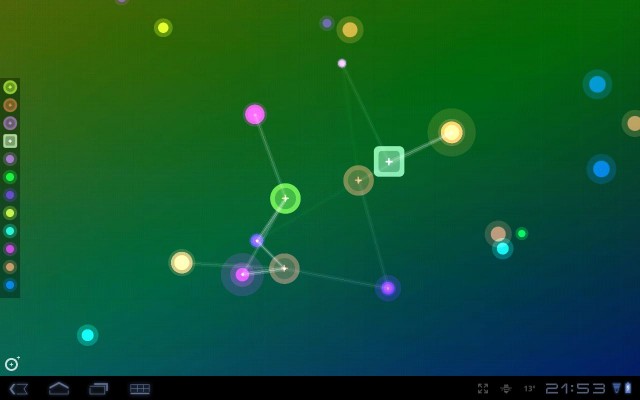NodeBeat is the kind of experimental music application that’s thriving in the age of the multi-touch tablet. Its dynamic interface and sound are built on the foundation of free and open source software tools regularly covered here on CDMusic and Motion. OpenFrameworks, the Processing-like C++ library, handles the UI, as libpd, the embeddable version of graphical media environment Pure Data, manages the sound.
What you get is an open-ended plane on which you can graphically array sequences, far away from the standard grid, for generative and sequenced music. It’s good fun, which made it a hit on iOS. Developer Seth Sandler, working with Justin Windle, did a brilliant job. Then, earlier this month, NodeBeat made the jump to Android, with additional porting work by Laurence Muller. Android has been getting tablets that can hold their own — I’ve enjoyed my Samsung Galaxy Tab 10.1, for instance. But the platform has remained severely starved of applications in contrast to iOS, but at least in place of quantity, there’s some quality: this application being one, tools like Mikrosonic’s RD3 or Reactable orControl or Nanoloop qualifying, too. (I’m not delusional; this does not make it at this point any serious competition for iOS, but it does demonstrate potential for developers. And I’ve already had the chance to use Reactable and Control in live performance, personally.)
That is, NodeBeat was temporarily available on Google’s Android Market. Then, without warning, Google suspended developer Seth Sandler’s seller account. This led to an extended discussion with Seth, other developers, and myself as we watched events unfold, ironically on Google’s own Google+. (Yes, that Google product works, despite what you’ve heard.)
It’s back now, so please, go buy and review it if you get the chance. If you’ve got a compatible Android, you’ve got truly no excuse as it’s a delightful app, and it holds up even in the crowded iOS platform:
NodeBeat @ Android Market
http://nodebeat.com/ (iOS and all versions; there’s even a free, desktop version with source code!)
Okay? Bought it? Good. Now it’s time to talk about how bad this is for a developer.
The account suspension on the Market represents a series of obvious flaws. First, of course, it shouldn’t have happened in the first place – Google support eventually acknowledged the suspension was entirely random, “incorrectly suspended” in the words of support, with no other explanation.
Second, support was largely nonexistent. Days passed during which Seth was left without any information. (Amidst discussions of how “evil” or “open” Google is, I’d sometimes be happy just to see them seem something other than desperately rushed. And that seems to be the primary “Apple-fication” of the market – the company’s rivals now are so rushed to try to compete that they screw things up constantly. “Don’t be crappy.”)
Third, and most bizarre, the application stayed available but payment was impossible, leaving customers confused and unable to buy the app.
Now, horror stories like this weren’t unheard of in the early days of the Apple App Store, and I still hear – with, happily, much less frequency – complaints from developers about Apple’s store and approval process. Apple deserves credit for ironing out those flaws, but from the skeptical perspective of a developer, It’s hard not to draw the conclusion that you may want to consider distributing your software via more than one means. Even as Apple fails to allow that on their mobile devices, that means considering going cross-platform. That’s not a philosophical claim; from the perspective of a developer, you don’t want to be dependent on only one company. Feel free to disagree, but my experience has shown otherwise as I’ve watched developers get burned. (And it’s worth noting that while Google couldn’t sell Seth’s app, Apple could.) Technically, via Android, developers are free on the vast majority of devices to sell direct or sell via alternative stores; unsurprisingly, Seth submitted his app to the competing Amazon App Store and is awaiting approval there.
None of this, of course, excuses Google from a big customer failure on Android Market. And whereas Apple’s earlier hiccups occurred as it was the only game in town, Google is making an uphill battle even worse. With Amazon’s Fire on the horizon, there are two questions to watch: one, can Amazon deliver enough tablets to create the tablet market Android has thus far lacked, and two, will their store deliver a better experience? Meanwhile, Google continues to promise a better Market; it’s all I hear about at developer events, largely because it’s the primary complaint from developers. As tech pundits make largely-unsupported claims like “Android users don’t like to buy software,” as if they’re a bunch of degenerate freeloaders, I’d point to the often-inferior Market and frustrating hardware experiences.
But, let’s put it this way: in addition to the obvious range of iOS choice, yes, there are superb applications beginning to appear on Android. For that, I credit developers like Seth and his collaborators. Even as we push for better audio performance, some of those applications are already running exceptionally well on new tablets and higher-end phones. If you have one of these devices, you can fire these up and enjoy making some sounds. And because you can’t always rely on another vendor to get things right, having cross-platform, free and open source tools behind these applications means developers have the flexibility to adapt to a changing market, and to focus on creative design and not constantly reinventing the wheel.
Here are some notes on NodeBeat’s creation on our forums.
And let us know what you think of NodeBeat, or if you do have an Android device you’re using for music (or a Fire on pre-order, for that matter).
